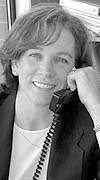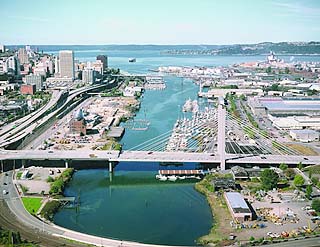
Surveys
DJC.COM
July 17, 2003
Foss Waterway cleanup kicks into high gear
EnviroIssues

Serie
|

Adams
|
Go back in time, over a century ago, when cities thrived on waterfront access because it was key to industrial growth and transportation.
The city of Tacoma grew up along the banks of the Thea Foss Waterway. Runoff from the growing city went to the waterway. Wood-treating sites, a coal gasification plant, chemical and shipbuilding companies, and other industries were also operating near and adjacent to the Foss.
Twenty years ago, the Thea Foss and Wheeler Osgood waterways were listed by EPA as part of the Commencement Bay federal Superfund site because of contamination that had been released into the waterways since before the turn of the previous century.
Between 1983 and 1989, EPA and the state Department of Ecology investigated the contamination and identified cleanup remedies for contaminated sediments. During this time, EPA identified parties it believed were potentially liable for cleanup, and asked for more detailed information from dozens of entities — some still operating on and around the waterways, and some who owned previously contaminated property.
The challenge was deciding how much of the cleanup bill — over $55 million — would be paid by each party.

Photo courtesy of EnviroIssues
The Thea Foss Waterway in Tacoma is undergoing extensive cleanup, above and below the waterline.
|
In the early 1990s, the city of Tacoma agreed with EPA to develop a cleanup plan for the waterway. Many of the potentially liable parties joined with them to participate in the investigation and design process.
As cleanup grew closer, a larger number of parties were engaged in discussions about relative shares of liability and paying for the remedy. This is where EnviroIssues came in, asked by EPA and the participants to convene and facilitate a voluntary participants group.
Seed money provided by EPA’s alternative dispute resolution program funded the early part of the effort, and participants provided the dollars needed to complete the process. The group chose an arbitration approach and worked with a neutral arbiter to analyze piles of detail on historic operations affecting the waterways.
The result was a settlement agreement among over 75 parties last year that allowed final consent decrees to be entered, and get cleanup under way at long last.
But even before the cleanup funding and plans were certain, the city of Tacoma boldly moved forward to get redevelopment along the Foss moving. It began by the city buying the majority of the contaminated properties along the western shoreline of the Foss Waterway. Then, working closely with all stakeholders in the area — businesses, environmental groups, regulators and residents — the city established the Foss Waterway Development Authority.
The development authority’s efforts included a master plan for the western portion of the waterway, shoreline improvements and fostering of private redevelopment of formerly contaminated on-shore properties.
Ecology has cleaned up or supervised the cleanup of numerous contaminated upland sites, allowing redevelopment to move ahead. Some of the funding for public investment in remediation of uplands sites was provided by Ecology through Model Toxics Control Act resources.
Today, sitting on the patio of the Museum of Glass or walking the esplanade in front of new residences, you can’t miss the progress. On a sunny day, it is hard to imagine a finer place to enjoy the view, including traditional waterway businesses and the new neighbors that are being integrated into the scene.
Museum of Glass visitors have topped the museum’s estimates. The Albers Mill historical redevelopment is slated to open this fall, with commercial and residential uses. New residents along the waterway enjoy marine views and a growing set of retail and commercial services.
Marinas are improving their in-water facilities, new open space is emerging and increased recreational use of the waterway is coming to life. But beneath the water, contaminated sediments still remain to be cleaned up.
And that’s the other great part of the story — progress on in-water cleanup.
Last December, the city of Tacoma and many of the parties who have been instrumental in making cleanup happen celebrated a “sand toss” event to kick off cleanup of six sites within the Foss and Wheeler Osgood waterways.
Bank stabilization, piling and debris removal, sediment capping and habitat improvements were part of the work performed during the first “fish window” for migratory salmonids. Done on time, these first cleanups set the tone for getting cleanup under way.
This summer, the real work moves ahead. Two utilities, PacifiCorp and Puget Sound Energy, are cleaning up about 20 percent of the area of the Foss, the portion right at the head of the waterway. They will install a soil cap over contaminated sediments in that area.
The city of Tacoma will start work this summer on the rest of the waterway, a mix of dredging, capping and monitored recovery, which will be finished in two to three field seasons.
Future stewardship of the waterway is also a focus of all the players involved — the city, the utilities, development authority, Ecology, EPA, Citizens for a Healthy Bay, Department of Natural Resources, and the businesses and residents around the waterway.
So watch the Foss this summer, and watch Tacoma continue to work together with its partners to make the Foss community a better place to live, work and play.
More information on the Foss cleanup can be found at www.cityoftacoma.org/fosscleanup, or by calling the Foss cleanup information line at (253) 233-1995. Redevelopment question? Contact the Foss Waterway Development Authority at (253) 597-8122 or visit www.theafoss.com.
Pat Serie is a principal with EnviroIssues, a 26-person Seattle firm providing community outreach, facilitation and technical integration services. She and EnviroIssues associate Diane Adams convened and facilitated the Thea Foss Participants Group and now support community outreach along the Foss Waterway.
Other Stories:
- Battle over keeping dams rages on
- Be prepared with a spill management plan
- What’s your vision for Seattle’s future?
- Hat Island gets a drink from the sea
- Reclaimed water — a ‘new’ water supply
- LOTT dives into reclaimed water
- Clean air: saving our competitive advantage
- Europe points the way to sustainability
- Old maps handy for site investigations
- Planning for an environmental emergency
- Engineered logjams: salvation for salmon
- Pierce County maps where its rivers move
- Development can be beneficial to wetlands
- Check out properties with microbial surveys
- Sculpting a park out of a brownfield
- Charting a sustainable course for the Sound
- Water rights no longer a hidden asset
- The economics of sustainability
- Laying the path for responsible education
- Squeezing more out of renewable energy
- Controlling mosquitos and the environment
- Beavers back in force in the Seattle area
- Our future: no time or resources to waste
- Port Townsend dock promotes fish habitat
- Brownfields program is here to stay
- Master Builders teaches green homebuilding
- A salmon-friendly solution on the Snake
Copyright ©2009 Seattle Daily Journal and DJC.COM.
Comments? Questions? Contact us.